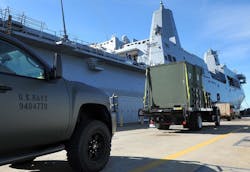Building a safer and more sustainable Navy
INDIANAPOLIS. The Green Truck Summit kicked off today with a decidedly military feel as keynote speaker Capt. Alex Stites, director of shore energy for the U.S. Navy, delivered an overview of the Navy’s alternative fuel and sustainability approach to a packed house here in Indianapolis.
“If we can make our ships so they use less fuel, we reduce their vulnerabilities,” he told the audience. Stites said that the Navy’s latest aircraft is 60% more energy intensive than previous models; its ships 70% more energy intensive. “As we move to new weaponry like rail guns, which are not a myth, those weapon systems are extremely energy intensive and our ships need to support them.”
The Navy has a 2-pronged approach to alternative fuels, Stites said. First is energy security and secondly is energy independence.
“How do you increase the use of alternative fuels and reduce our use of petroleum usage, which protects our troops,” he asked rhetorically.
By 2050, Stites said, the world will have 55% more water due to global warming and use 80% more energy. The Navy intends to cut its petroleum use in its commercial fleet 50% by this year and increase alternative fuel usage to 50% by 2020.
Put simply, Stites said, “the thing being bought has to be more energy efficient than the thing it is replacing.”Part of its approach is building the “Great Green Fleet.” That initiative aims to have the entire fleet of naval ships running on biofuels by 2016. Stites said they are on track to meet that goal, but the commercial fleet conversion is taking longer.
With a large fleet, some 45,000 non-tactical vehicles, 12,000 of which are medium- and heavy-duty trucks, the conversion to alternative fuels for the Navy’s fleet is taking time.
“I think on the medium- and heavy-duty side we will be pushed by 2020,” Stites said. ‘I think it’s more related to procurement because those vehicles we typically buy and keep them 10 years.
“On non-tactical vehicles, we don’t develop those; we buy them, so we look to industry for the new technologies,” he added.
Stites pointed out that the Navy’s approach to sustainability runs the gamut, including wind and solar power, including “man-packed” solar panels, which are individual solar panels that can be deployed in the field.
“[Soldiers] can put them in tandem from one to 50 to run communications, lighting,” Stites said. “And every one of those is carried on the back of a Marine as they go into the fight.”

